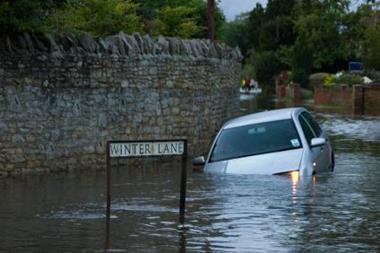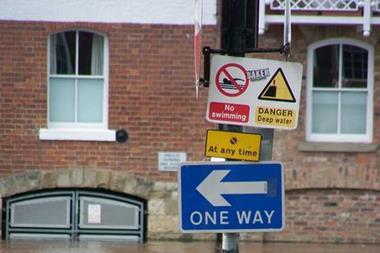Baroness Young explains how the Environment Agency is dealing with flood defences and defends her controversial call for insurers to withdraw cover from homes built on flood plains
As she strides into the lobby of Bournemouth’s Connaught Hotel, Baroness Young strikes me as a woman with nothing to hide. The chief executive of the Environment Agency (EA) is about to address a room full of hostile insurers at the ABI’s Labour party conference fringe event.
But she arrives without the politician’s usual phalanx of press secretaries and minders, and appears to have all the time in the world.
Caught between a coffee lounge and a Fabian Society function, I sit down with the woman who recently infuriated the industry with the outspoken suggestion that insurers should enforce the agency’s planning recommendations where local authorities fail to – by withdrawing their cover.
Having arrived 10 minutes early, she greets me with the disarming question: “So you’re the flooding expert?”
Blimey. As I try to work out an answer to that one, the real expert, who looks more like the head of a grammar school’s English department than the seasoned politician and lobbyist she actually is, checks her phone and settles down for business.
Stemming the tide
For Baroness Young, former chief executive of the RSPB and one time vice chair of the BBC, the floods are old news. When she joined the agency in 2000, it was in the midst of another flooding crisis. “We were up to our necks in it,” she recalls with a wry twinkle. She is clearly a woman who revels in such times.
But despite the pleasantries and the soothing, favorite aunt-like manner, Young has some tough questions to answer: did the Environment Agency and the government do enough to prevent or mitigate this summer’s floods, and have they learned the lessons? When will the agency receive the £800m of funding for flood defences that the government has promised?
Young tells me that the government deserves credit, not censure, for having increased the agency’s budget from £350m at the time of her arrival to its current mark of £564m but, tellingly, she is unable to say when the new funding will hit the bank account.
Instead she is quick to point out that less than one per cent of floods result from flood defence failure. Yet I can’t help but wonder if she is putting a brave face on it.
When referring to a National Audit Office report in June that revealed that almost two thirds of the nation’s flood defences were not in their target conditions, for example: “[It] was fairly balanced. It was the subsequent publicity that got out of hand.
“As soon as we have decent, reliable data the insurance industry is the first to have it.
“We have to try to reassess what our condition assessments actually mean.”
At present flood defences are rated on a scale of one to five with three being fair – 85% of the flood defences in England and Wales are in that condition or better, which Young believes is sufficient.
She plays down the suggestion that her background in the public sector may have nurtured an inherent hostility to the insurance industry. In fact, having been burgled eight times in London alone, she is delighted with its efforts – not to mention the state of her electronic appliances. “I’ve never had so much up-to-date audio equipment in my life.
A question of data
The EA has also come under fire for failing to share its data on flood defences with the industry. But Young questions the claim, describing its assets database as “an incredibly meticulous and boring list”.
Perhaps this list that Norwich Union so vigilantly - but in her eyes gratuitously - covets is inside the folder resting neatly on her lap. “Norwich Union is a bit more antsy because it has its own system,” she says. “It likes having a go at ours in order to demonstrate how good its own one is.
“We’re not keeping it from [insurers],” she continues. “As soon as we have decent, reliable data the insurance industry is the first to have it.”
You heard it here first.
Moving on to flood resilience, a topic with which she seems more at ease, Young suggests the introduction of a minimum flood resilience standard. More controversially, she calls for insurance premiums – or at the very least policy excesses – to be graded according to how well homes are equipped to resist floods. The question is, who will pay for it?
“Going from £30,000 reinstatement costs to £5,000 or £6,000 makes a difference. You guys can do the sums,” she says. That’ll be the insurers then.
She suggests that developers and householders should also play their part but, curiously, the government is not included as part of her proposal.
“[Withdrawing flood cover] would be a severe thing to do, but developers would get the message quickly. There is useful leverage in the market insurers can provide.
Cutting the EA's teeth
All this to one side, the fiercest and most sustained criticism Young faces is that her agency is ineffective. The Labour peer – who gave up the whip when she joined the agency in 2000 – tells me that it “stamps its foot” at the government from time to time. But where is the evidence?
In 2005, the most recent year for which data is available, at least 10 major housing developments went ahead on flood plains in flat defiance of the agency’s advice. This, she says, is “10 too many” – which begs the question, why didn’t the agency stop it and, if it couldn’t, then what is the point of the agency at all?
The Baroness is far too astute to be drawn into such a debate, but she does say that the agency is preparing to use its power to refer planning applications to the Secretary of State for independent adjudication. The fact that it has had the option for 10 months, but is yet to exercise it, is a worrying sign.
“We need to use [that power] to have more teeth,” she says – the closest she will come to an admission it is currently toothless.
Another problem that the EA faces is that local authorities are under no obligation to respond to its rulings, let alone act upon them. 95% of those that do fully adhere to its wishes, but in many cases only after repeated objections.
Despite growing awareness among the public and local authorities about the nature and extent of flood risk, only 41% of the population have signed up for the agency’s free flood warning service – a figure that Young brands “pathetic”.
How does she propose to raise that number, or to improve co-ordination between the multiple agencies that play a part in flood management?
A strategic outlook
“We need a much more strategic look at surface water drainage,” she says. “There are so many bodies that impact on the issue: local authorities, developers, redevelopers, the Highways Agency, water companies and us.”
Though Young talks of a market solution, she staunchly opposes developers providing insurance for properties built in flood prone areas (a suggestion raised by Labour MP Alan Simpson in July) on the ground that it is “incentivising the process in the wrong direction”.
If that is the case, how is her proposal that insurers should withdraw flood cover moving in the right direction? Given that the government has already committed to building hundreds of thousands of homes on flood plains, what would this mean for would-be mortgage buyers, or the swathes of uninsured who could ultimately end up paying the price?
“We need to use [PPS25] to have more teeth.
Defending her position she says, in her best schoolmarm tones: “It would be a severe thing to do, but developers would get the message quickly. There is useful leverage in the market insurers can provide.”
In the wake of the recent floods, with thousands of homes in need of repair, now is the time to provide it, she stresses.
Insurers might agree, but few would say that withdrawing cover either presents a viable solution from a commercial perspective, or would be welcomed by the public.
Charming, intelligent and obviously sincere though she is, she is unlikely to win the insurance industry over. But Young won’t be disheartened.
“There’s no better job in the world than to be given a billion pounds a year and told to go and do good things for the environment,” she says with an emphatic grin before heading off to face down those insurers.
Hosted by comedian and actor Tom Allen, 34 Gold, 23 Silver and 22 Bronze awards were handed out across an amazing 34 categories recognising brilliance and innovation right across the breadth of UK general insurance.












































No comments yet